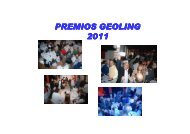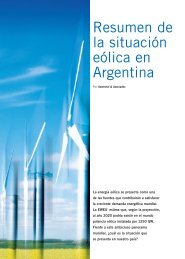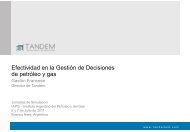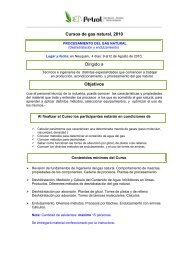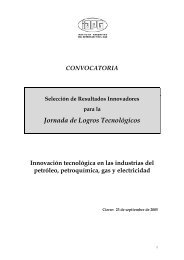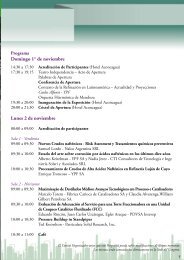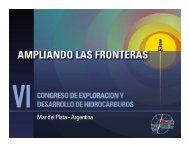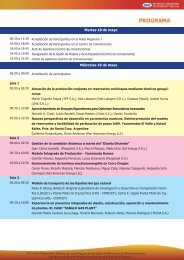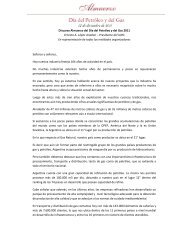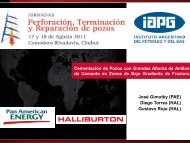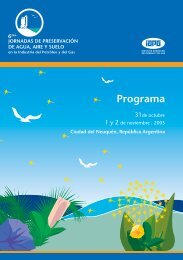Deteccion y Cierre de Agua TTL - Instituto Argentino del Petroleo y ...
Deteccion y Cierre de Agua TTL - Instituto Argentino del Petroleo y ...
Deteccion y Cierre de Agua TTL - Instituto Argentino del Petroleo y ...
You also want an ePaper? Increase the reach of your titles
YUMPU automatically turns print PDFs into web optimized ePapers that Google loves.
Detección y <strong>Cierre</strong> <strong>de</strong> <strong>Agua</strong> en Cerro Dragón utilizando<br />
TargeTT*Logging<br />
Ana Pithon (Pan American Energy)<br />
Mariano Ballarini (Pan American Energy)<br />
Pablo Barrionuevo (Schlumberger)<br />
Jornadas <strong>de</strong> Producción y Recuperación Secundaria – EOR<br />
23 y 24 <strong>de</strong> Agosto 2012<br />
Comodoro Rivadavia, Chubut
Planteamiento <strong>de</strong>l Problema<br />
La producción <strong>de</strong> <strong>Agua</strong> incrementa con el tiempo – Viabilidad Económica <strong>de</strong><br />
Campos Maduros?<br />
No resulta extraño ver casos <strong>de</strong> Corte <strong>de</strong> <strong>Agua</strong> > 95%.<br />
Mecanismos típicos <strong>de</strong> Producción con Levantamiento Artificial – Bombeo<br />
Mecánico /BES.<br />
Diámetros <strong>de</strong> Completación Pequeños – Casings
Planteamiento <strong>de</strong>l Problema<br />
Los Diagnósticos Requieren la Intervención con Wireline.<br />
Limitado acceso al pozo con las convencionales Y-Tools:<br />
• Mínimo Diámetro <strong>de</strong> Casing 7” .<br />
• BES no pue<strong>de</strong> estar en el fondo <strong>de</strong>l pozo.<br />
Y-Tool<br />
Tele-Swivel<br />
Bypass Clamps<br />
Bypass Tubing<br />
W.E..G.<br />
(Wireline Re-Entry Gui<strong>de</strong>)<br />
Well Casing<br />
Handling Sub<br />
Top Nipple<br />
Pump Sub<br />
ESP Discharge<br />
Head<br />
Discharge Pressure<br />
Sub<br />
ESP Pump<br />
ESP Protector<br />
ESP Motor<br />
ESP Gauge<br />
Motor Base Plug
Consecuencias<br />
• Diagnósticos <strong>de</strong> Producción no siempre precisos.<br />
• Trabajos <strong>de</strong> remediación sin lograr siempre el resultado <strong>de</strong>seado.<br />
• Instalaciones <strong>de</strong> superficie limitadas por la producción <strong>de</strong> agua.<br />
• Alto costo <strong>de</strong> elevación <strong>de</strong> líquidos no <strong>de</strong>seados.<br />
• Alto costo <strong>de</strong> tratamiento y disposición <strong>de</strong> agua.<br />
• Campos maduros: Transición <strong>de</strong> marginales a no viables.
Una Solución Integrada<br />
TargeTT* Logging<br />
Una técnica multidisciplinaria e innovadora que permite obtener un<br />
diagnostico <strong>de</strong> producción en tiempo real bajo condiciones dinámicas.<br />
La solución consiste en la realización <strong>de</strong> un Perfil <strong>de</strong> Producción <strong>de</strong>bajo <strong>de</strong><br />
una Bomba Electro-sumergible. El sistema pue<strong>de</strong> ser bajado con coiled -<br />
tubing o con tubing (equipo <strong>de</strong> WO o Pulling).<br />
La interpretación en tiempo real permite la <strong>de</strong>terminación <strong>de</strong> las zonas<br />
productoras <strong>de</strong> agua, para la i<strong>de</strong>ntificación <strong>de</strong> oportunida<strong>de</strong>s <strong>de</strong> water<br />
shutoff.
PLT-Production Services Logging Platform (PSP)<br />
Herramienta <strong>de</strong> registro <strong>de</strong> producción lí<strong>de</strong>r en la industria permite obtener un perfil<br />
<strong>de</strong> producción trifásico.<br />
Las Medidas Básicas son:<br />
• Mediciones <strong>de</strong> flujo vía full bore spinner.<br />
• Medidas <strong>de</strong> Temperatura y Densidad.<br />
• Flow View – I<strong>de</strong>ntificación Eléctrica <strong>de</strong> Fluidos.<br />
• GHOST – I<strong>de</strong>ntificación Óptica <strong>de</strong> Fluidos.<br />
1% <strong>de</strong> Variaciones en aportes <strong>de</strong> <strong>Agua</strong>/<strong>Petroleo</strong> y Gas & <strong>de</strong>tectadas con precisión.
Bomba Electrosumergible - BES<br />
Motor serie: Dominator 375<br />
Performance optimizada con avanzados diseños <strong>de</strong> estatores<br />
y rotores, mejoran el rango <strong>de</strong> potencia.<br />
59,5HP por cuerpo, disponibilidad <strong>de</strong> diseño en tán<strong>de</strong>m<br />
(60HP, 120 HP, 180HP or 240hp).<br />
Phoenix Select Sensor<br />
Presión, Temperatura,<br />
Vibraciones Sensor pue<strong>de</strong><br />
trabajar hasta los 150°Celsius<br />
<strong>de</strong> temperatura <strong>de</strong> fondo.<br />
Varistar<br />
Accionamiento <strong>de</strong> Velocidad Variable, 200 KVA a 520 KVA.<br />
Utilizado conjuntamente con el Sensor Phoenix, protege el equipo.<br />
Permite varios modos <strong>de</strong> operación, como trabajar en modo presión.<br />
Varistar<br />
Dominator motor
Conjunto <strong>de</strong> Cabeza <strong>de</strong> Pozo<br />
• Todo el equipo armado en el pozo con<br />
equipo <strong>de</strong> pulling o con Workover.<br />
• El equipo <strong>de</strong> control <strong>de</strong> presión “Hércules”<br />
se monta encima <strong>de</strong>l equipo <strong>de</strong> presión <strong>de</strong>l<br />
pozo.<br />
• Integridad <strong>de</strong> Presión durante la fluencia:<br />
Cable <strong>de</strong> Wireline – Equipo <strong>de</strong> control<br />
<strong>de</strong> Presión.<br />
Cable BES – Sellado en la Cabeza <strong>de</strong><br />
Pozo Hércules.
Secuencia <strong>de</strong> Armado<br />
• La herramienta <strong>de</strong> Perfil <strong>de</strong> Producción se baja con cable con el equipo<br />
<strong>de</strong> control <strong>de</strong> presión estándar.<br />
• Luego la BES se baja al pozo con tubing.<br />
• El Pozo se produce con diversos caudales para generar múltiples<br />
condiciones dinámicas <strong>de</strong> fondo.<br />
• Una vez que el flujo es estable, se realiza la secuencia <strong>de</strong> PLT (pases +<br />
estaciones). El PLT está posicionado <strong>de</strong>bajo <strong>de</strong> la BES.<br />
Esta es la primera vez que se pue<strong>de</strong> correr un PLT en pozos que no fluyen<br />
naturalmente en casing <strong>de</strong> 5 ½”.
•10<br />
10<br />
Técnica <strong>de</strong> Completación Estándar – Patagonia<br />
• Pozos no fluyen naturalmente (No Surgentes).<br />
• 20-30 zonas punzadas.<br />
• Corte <strong>de</strong> <strong>Agua</strong> > 95%.<br />
• Se prueba cada zona con pistoneo.
11<br />
Técnica <strong>de</strong> Completación Estándar – Patagonia<br />
Correr Casing<br />
Perforar Capa<br />
Correr Tubing<br />
Pistoneo y Test<br />
Aislar si H20<br />
Perforar la<br />
siguiente zona<br />
Pistoneo y Test
12<br />
Técnica <strong>de</strong> Completación Alternativa – Patagonia<br />
Correr<br />
Casing<br />
Perforar Zonas<br />
Fluir el pozo<br />
Con BES<br />
Correr PLT<br />
Cerrar Zonas con <strong>Agua</strong><br />
Durante la completación
Resultados<br />
• Don<strong>de</strong> antes estábamos ciegos, ahora po<strong>de</strong>mos ver.<br />
• Resultados y revelaciones <strong>de</strong>l Perfil <strong>de</strong> Producción:<br />
Petróleo ingresando <strong>de</strong> intervalos inesperados.<br />
Capas cementadas produciendo petróleo o agua.<br />
Capas ladronas admitiendo petróleo & agua (Cross Flow).<br />
• Primeros PLTs realizados en pozos no surgentes con casing <strong>de</strong> 5.5”.<br />
• En pozos que producen 2% <strong>de</strong> petróleo y 98% <strong>de</strong> agua, tenemos la capacidad<br />
para <strong>de</strong>terminar las entradas <strong>de</strong> petróleo/gas para cerrar gran<strong>de</strong>s volúmenes <strong>de</strong><br />
agua.
Utilización <strong>de</strong> la herramienta en Cerro Dragón<br />
TargeTT*Logging
Objetivos<br />
• Analizar el comportamiento dinámico <strong>de</strong> los distintos reservorios<br />
produciendo en conjunto.<br />
• I<strong>de</strong>ntificar zonas barridas y/o alto aporte <strong>de</strong> agua.<br />
• Evaluar aporte <strong>de</strong> capas no ensayadas durante la completación<br />
<strong>de</strong>l pozo, seguir evolución <strong>de</strong> capas fracturadas.<br />
• I<strong>de</strong>ntificar cross flow en condiciones estáticas / dinámicas.<br />
• I<strong>de</strong>ntificar la hermeticidad <strong>de</strong> capas cementadas.
Situación Inicial<br />
Objetivo<br />
Estrategia<br />
Datos históricos<br />
Estadísticas<br />
Análisis <strong>de</strong> Mallas<br />
Correlaciones<br />
Ensayos <strong>de</strong> Pistoneo<br />
Metodología<br />
Seguimiento <strong>de</strong><br />
Pozos Disposal<br />
Balance <strong>de</strong> <strong>Agua</strong><br />
Reducción<br />
3000 m3/d<br />
Trabajos <strong>de</strong> WSO<br />
Incertidumbre en ensayos<br />
<strong>de</strong> pistoneo<br />
Alto número <strong>de</strong> capas por<br />
pozo<br />
Problemática<br />
Optimización<br />
red <strong>de</strong><br />
transferencia<br />
Incremento<br />
Inyección<br />
INCORPORAR<br />
NUEVAS TECNOLOGÍAS<br />
Necesidad
Metodología Utilizada<br />
Planteada la necesidad <strong>de</strong> mejora en las intervenciones <strong>de</strong> WSO, nos propusimos el<br />
objetivo <strong>de</strong> lograr mayor precisión en la <strong>de</strong>tección <strong>de</strong> capas con alto WOR.<br />
En 2010 se <strong>de</strong>cidió evaluar la tecnología TargeTT*Logging para su aplicación en un<br />
piloto. Para ello se <strong>de</strong>finió un Protocolo <strong>de</strong> Ensayo don<strong>de</strong> se involucraron a los<br />
sectores <strong>de</strong> IPRS/DDR, WELL SERVICE, WORKOVER, OPERACIONES, ENERGIA,<br />
INSTRUMENTACIÓN, CONTRATACIONES y SEGURIDAD para diseñar la secuencia<br />
operativa.<br />
Mejora<br />
WSO<br />
IP&RS / DDR<br />
OPERACIONES<br />
PILOTO<br />
<strong>TTL</strong><br />
WO / PULL<br />
LOGISTICA<br />
SEGURIDAD<br />
Evaluación Plan WSO<br />
2011<br />
ENERGIA
1000<br />
100<br />
10<br />
1<br />
Secuencia <strong>TTL</strong><br />
Diseño y<br />
Programa<br />
Operativo<br />
PCD-862<br />
Seguimiento<br />
0<br />
3-2011 6-2011 9-2011<br />
50<br />
40<br />
30<br />
20<br />
10<br />
[mMD]<br />
0.00<br />
1280.02<br />
1302.50<br />
1318.50<br />
1368.00<br />
1428.50<br />
1436.00<br />
1453.00<br />
1470.00<br />
1474.00<br />
1483.50<br />
1499.00<br />
1504.00<br />
1510.00<br />
1524.00<br />
1567.50<br />
1605.00<br />
1613.5<br />
PULL / WO<br />
Secuencia<br />
Operativa<br />
55<br />
56<br />
51<br />
58<br />
59<br />
57<br />
Trabajos<br />
Remediación<br />
PCD-862<br />
Ensayo <strong>TTL</strong><br />
Resultados PLT
Situación Mejorada<br />
[mMD]<br />
1500<br />
2000<br />
La diferencia con las técnicas utilizadas normalmente y la herramienta actual, es<br />
básicamente 21 que el <strong>TTL</strong> nos brinda con gran precisión el aporte real <strong>de</strong> cada<br />
capa, y es posible correr un perfil <strong>de</strong> producción en pozos con sistema artificial <strong>de</strong><br />
extracción.<br />
Cabe <strong>de</strong>stacar que este fue el primer piloto en la Argentina y en el mundo en<br />
Casing <strong>de</strong> 5 ½”.<br />
4<br />
4 12<br />
4<br />
4<br />
4<br />
4<br />
11<br />
13<br />
13 19<br />
13<br />
13 18 20<br />
13<br />
13<br />
13<br />
13 17<br />
13<br />
13<br />
13<br />
13<br />
13 16<br />
13<br />
13 15<br />
13<br />
14<br />
4 10<br />
4<br />
9<br />
4<br />
4 8<br />
4<br />
7<br />
4<br />
6<br />
4<br />
4<br />
5<br />
08-08-2004 10-10-2008<br />
27<br />
26<br />
25<br />
24<br />
30 31<br />
28 29<br />
32<br />
34<br />
33<br />
36<br />
35<br />
PCG-898<br />
Pocos ensayos individuales<br />
Comportamiento dinámico <strong>de</strong><br />
todo el pozo
Situación Mejorada<br />
Pozos Candidatos Para WSO<br />
RAP (m3/m3)<br />
80<br />
70<br />
60<br />
50<br />
40<br />
30<br />
20<br />
10<br />
0<br />
50 100 150 200 250 300<br />
<strong>Agua</strong> Producida (m3/TE)
Situación Mejorada<br />
RAP (m3/m3)<br />
Pozos Candidatos Para WSO<br />
80<br />
70<br />
60<br />
50<br />
40<br />
30<br />
20<br />
10<br />
0<br />
50 100 150 200 250 300<br />
<strong>Agua</strong> Producida (m3/TE)<br />
<strong>Agua</strong> > 180m3/d<br />
RAP> 30<br />
76 pozos
TARGETT LOGGING<br />
Ejemplos Aplicación<br />
CERRO DRAGON
Resultados<br />
Capas cementadas<br />
Liq: 330<br />
m3/d<br />
Oil: 14<br />
m3/d<br />
WSO-<strong>TTL</strong><br />
Liq: 208<br />
m3/d<br />
Oil: 12<br />
m3/d
Resultados<br />
Liq: 300<br />
m3/d<br />
Oil: 4<br />
m3/d<br />
WSO-<strong>TTL</strong><br />
Capas aisladas con TPN<br />
Liq: 74<br />
m3/d<br />
Oil: 5<br />
m3/d
Resultados<br />
Capa cementada<br />
Liq:<br />
220<br />
m3/d<br />
Oil: 4<br />
m3/d<br />
WSO -<strong>TTL</strong><br />
Liq:<br />
100<br />
m3/d<br />
Oil:<br />
2.5<br />
m3/d
TARGETT LOGGING<br />
Curva Total <strong>de</strong> Trabajos 2011<br />
Mes<br />
RAP<br />
[m³/m³] qo[m³/d] qw[m³/d]<br />
1 31 65 1984<br />
2 30 63 1896<br />
3 30 58 1750<br />
4 31 57 1772<br />
5 30 48 1450<br />
6 26 30 770<br />
7 24 44 1052<br />
8 22 42 950<br />
9 22 47 1045<br />
10 23 48 1095<br />
11 21 50 1063<br />
Perdida<br />
<strong>Petroleo</strong><br />
(m3/d)<br />
Reducción<br />
<strong>de</strong> <strong>Agua</strong><br />
(m3/d)<br />
RAP: 65 14 921<br />
m3/d<br />
2000<br />
1800<br />
1600<br />
1400<br />
1200<br />
1000<br />
800<br />
600<br />
400<br />
200<br />
0<br />
Curva Reducción <strong>de</strong> <strong>Agua</strong> <strong>TTL</strong> - 8 pozos<br />
WSO-<strong>TTL</strong><br />
1 2 3 4 5 6 7 8 9 10 11<br />
qo[m³/d] qw[m³/d] RAP [m³/m³]<br />
100<br />
90<br />
80<br />
70<br />
60<br />
50<br />
40<br />
30<br />
20<br />
10<br />
0<br />
m3/m3
Conclusiones<br />
Beneficios i<strong>de</strong>ntificados:<br />
I<strong>de</strong>ntificar capas <strong>de</strong> alta WOR en condiciones dinámicas.<br />
Detectar capas <strong>de</strong> bajo potencial <strong>de</strong> fluido con buen % <strong>de</strong> petróleo.<br />
I<strong>de</strong>ntificar cross flow en condiciones estáticas / dinámicas.<br />
I<strong>de</strong>ntificar la hermeticidad <strong>de</strong> capas cementadas.<br />
I<strong>de</strong>ntificar punzados tapados, con posible daño.<br />
Evaluar evolución capas fracturadas.<br />
Seguimiento <strong>de</strong> proyectos <strong>de</strong> secundaria.<br />
Riesgos y <strong>de</strong>bilida<strong>de</strong>s:<br />
Drift ajustado para maniobrar y recuperar las herramientas en caso <strong>de</strong> pescas,<br />
aprisionamiento.



